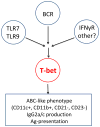Age-Associated B Cells: A T-bet-Dependent Effector with Roles in Protective and Pathogenic Immunity
- PMID: 26297793
- PMCID: PMC4548292
- DOI: 10.4049/jimmunol.1501209
Age-Associated B Cells: A T-bet-Dependent Effector with Roles in Protective and Pathogenic Immunity
Abstract
A newly discovered B cell subset, age-associated B cells, expresses the transcription factor T-bet, has a unique surface phenotype, and accumulates progressively with age. Moreover, B cells with these general features are associated with viral infections and autoimmunity in both mice and humans. In this article, we review current understanding of the characteristics, origins, and functions of these cells. We also suggest that the protective versus pathogenic actions of these cells reflect appropriate versus aberrant engagement of regulatory mechanisms that control the Ab responses to nucleic acid-containing Ags.
Copyright © 2015 by The American Association of Immunologists, Inc.
Figures


References
-
- Ben-Yehuda A, Weksler ME. Immune senescence: mechanisms and clinical implications. Cancer investigation. 1992;10:525–531. - PubMed
-
- Pawelec G. Immunosenescence and human longevity. Biogerontology. 2003;4:167–170. - PubMed
-
- Miller RA. The aging immune system: primer and prospectus. Science. 1996;273:70–74. - PubMed
-
- Doria G, Frasca D. Genes, immunity, and senescence: looking for a link. Immunological reviews. 1997;160:159–170. - PubMed
-
- Franceschi C, Passeri M, De Benedictis G, Motta L. Immunosenescence. Aging. 1998;10:153–154. - PubMed
Publication types
MeSH terms
Substances
Grants and funding
LinkOut - more resources
Full Text Sources
Other Literature Sources
Medical

